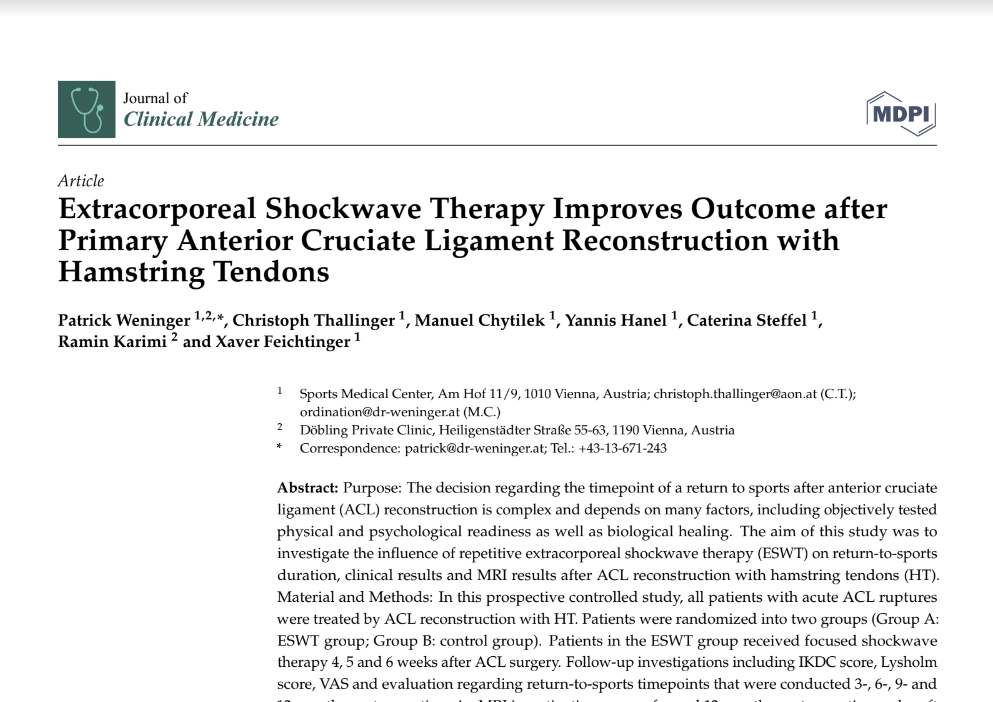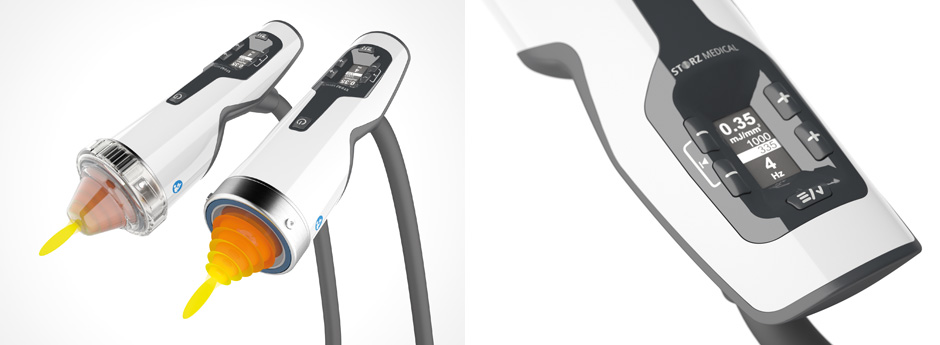Every year, thousands of people in the UK, undergo ACL reconstruction surgery to repair a torn anterior cruciate ligament in their knee. Surgery is often required to repair or reconstruct the ACL, and this typically involves using a graft from another part of the body, such as the hamstring tendons. While the surgery itself is a major step towards recovery, what happens after the operation is just as important.
A recent study by Weninger et al (2023) had shown that focused extracorporeal shockwave therapy (fESWT) can significantly improve outcomes for patients undergoing primary ACL reconstruction with hamstring tendons. fESWT is a non-invasive treatment that uses high-energy sound waves to stimulate healing in damaged tissues. It has been used for a variety of musculoskeletal conditions, including plantar fasciitis, achilles tendinopathy, tennis elbow and bone stress injuries. The study was conducted by a team of experts from the Sports Medical Centre in Vienna, Austria. In this blog post, we’ll take a closer look at this study and what it means for patients like you who are looking to get back on their feet after ACL surgery.

Study Design:
The trial was a prospective controlled trial that included 65 patients who underwent primary ACL reconstruction with hamstring tendons. The patients were randomized into two groups: one group received ESWT (37 patients) in addition to standard rehabilitation, while the other group received standard rehabilitation alone (the control group of 28 patients). The fESWT group received a total of three sessions of focused shockwave therapy with the Storz Medical Duolith device, each consisting of 1500 impulses at an energy flux density of 0.25 mJ/mm2
Outcome measures:
The primary outcome measure was the time to return to pivoting sports, which was defined as the time when patients were able to perform cutting and pivoting movements without pain or instability.
Secondary outcome measures included the time to return to running activity, the number of patients achieving their pre-injury activity level, and various clinical scores.
- The clinical scores used in this study included the International Knee Documentation Committee (IKDC) score, the Lysholm score, and the Visual Analog Scale (VAS) for pain.
- The IKDC score is a widely used measure of knee function that assesses symptoms, function, and sports activities.
- The Lysholm score is another commonly used measure of knee function that assesses pain, swelling, instability, locking, and limp.
- In addition to these clinical measures, MRI was also used to assess graft maturation at six months post-surgery.

Results:
The results showed that the ESWT group had significantly better outcomes than the control group in terms of pain reduction, range of motion improvement, and improvement in muscle strength.
Patients who received ESWT had a significantly shorter time to return to pivoting sports and running activity compared to the control group.
- The number of patients achieving their pre-injury activity level was significantly higher in the ESWT group.
- Clinical scores (IKDC, Lysholm, VAS) were significantly improved in the ESWT group for all timepoints.
- Graft maturation was clearly increased by ESWT, as evidenced by a higher signal-to-noise ratio on MRI at six months post-surgery.
Overall, these results suggest that ESWT can be a valuable addition to the recovery plan for patients undergoing ACL reconstruction surgery. By improving outcomes across multiple domains (e.g., functional outcomes, clinical scores, MRI), ESWT can help patients get back to their normal activities faster and with fewer complications. Further research is needed to investigate the long-term effects of ESWT on ACL reconstruction surgery.
Key take-home points:
- Extracorporeal Shockwave Therapy (ESWT) using STORZ Focus Duolith, can significantly improve outcomes for patients undergoing primary ACL reconstruction with hamstring tendons.
- ESWT can reduce pain, improve range of motion, and increase muscle strength in the affected leg, helping patients get back to their normal activities faster.
- ESWT is a non-invasive treatment option that can be performed in an outpatient setting, making it a convenient and accessible option for many patients. Further, it has minimal side effects and is generally well-tolerated by patients.
Conclusion:
In conclusion, the evidence is clear: focused shockwave therapy can significantly improve outcomes for patients undergoing primary ACL reconstruction with hamstring tendons. By reducing pain, improving range of motion, and increasing muscle strength, focused shockwave can help patients get back to their normal activities faster and with fewer complications.
What’s more, ESWT has been shown to have minimal side effects and is a non-invasive treatment option that can be performed in an outpatient setting. If you or someone you know is facing ACL reconstruction surgery, it’s worth considering ESWT as part of your recovery plan. Talk to your healthcare provider today to learn more about this innovative treatment option and how it can help you get back on your feet faster.
Benoy Mathew, MSc, MCSP,
Advanced Practice Physio & MSK Sonographer,
Head of MSK Education, Venn Healthcare




